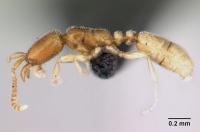Leptanilloides amazonus
| Leptanilloides amazonus | |
|---|---|

| |
| Scientific classification | |
| Kingdom: | Animalia |
| Phylum: | Arthropoda |
| Class: | Insecta |
| Order: | Hymenoptera |
| Family: | Formicidae |
| Subfamily: | Dorylinae |
| Genus: | Leptanilloides |
| Species: | L. amazonus |
| Binomial name | |
| Leptanilloides amazonus (Brandão, Diniz, Agosti & Delabie, 1999) | |
This species was collected in a soil sample in a forest reserve of tropical lowland primary forest near Manaus, Brazil.
Identification
The combination of head shape in full-face view, the flat dorsum of the trunk and the presence of a clearly defined declivity of the propodeum is unique for A. amazona.
Keys including this Species
Distribution
Distribution based on Regional Taxon Lists
Neotropical Region: Brazil (type locality).
Distribution based on AntMaps
Distribution based on AntWeb specimens
Check data from AntWeb
Countries Occupied
| Number of countries occupied by this species based on AntWiki Regional Taxon Lists. In general, fewer countries occupied indicates a narrower range, while more countries indicates a more widespread species. |

|
Estimated Abundance
| Relative abundance based on number of AntMaps records per species (this species within the purple bar). Fewer records (to the left) indicates a less abundant/encountered species while more records (to the right) indicates more abundant/encountered species. |

|
Biology
Castes
Worker
Images from AntWeb
   
| |
| Paratype of Leptanilloides amazonus. Worker. Specimen code casent0104669. Photographer April Nobile, uploaded by California Academy of Sciences. | Owned by AMNH, New York, NY, USA. |
    
| |
| Worker. Specimen code casent0101449. Photographer April Nobile, uploaded by California Academy of Sciences. | Owned by MNHN, Paris, France. |
    
| |
| Worker. Specimen code casent0178867. Photographer Erin Prado, uploaded by California Academy of Sciences. | Owned by MZSP, Sao Paulo, Brazil. |
Nomenclature
The following information is derived from Barry Bolton's Online Catalogue of the Ants of the World.
- amazonus. Asphinctanilloides amazona Brandão, Diniz, et al. 1999: 31, figs. 9, 10, 18, 25, 36-39, 68-74 (w.) BRAZIL (Amazonas).
- Type-material: holotype worker, 7 paratype workers.
- Type-locality: holotype Brazil: Amazonas, 4832, ca 70 km. N Manaus, Fazenda Esteio, Reserva 1202 (02°24’50’’S, 59°52’11’’W), ZF 23 Road, km. 28, Projecto Dinâmica Biológia de Fragmentos Florestais, INPA/Smithsonian, 12.xi.1993, soil sample M14, #1003(A.B. Casimiro); paratypes with same data.
- Type-depositories: INPA (holotype); AMNH, BMNH, CPDC, MCZC, MZSP (paratypes).
- Combination in Leptanilloides: Borowiec, M.L. 2016: 156.
- Distribution: Brazil.
Unless otherwise noted the text for the remainder of this section is reported from the publication that includes the original description.
Description
Two MZUSP paratypes (in mm): HL 0.35–0.35, HW 0.27–0.28, SL 0.16–0.17, WL 0.41–0.46, CI 76–79, SI 57–59, SRI 104.
The combination of head shape in full-face view, the flat dorsum of the trunk and the presence of a clearly defined declivity of the propodeum is unique for A. amazona sp.n. Other relevant characters include: head in full-face view with parallel sides and emarginate occiput; blunt teeth on genae produced; dorsal outline of alitrunk, in lateral view, straight, continuous, not interrupted by the promesonotal suture and metanotal groove which are present; relatively small body size (WL, 0.41 mm); dorsum of propodeum distinct from declivity; postpetiole ventral process bulging, large and rounded anteriorly. Venom apparatus: spiracular plate posterodorsal corner strongly tuberculate (Fig. 68), prominent; quadrate plate anterodorsal corner with acute apex (Fig. 69); anal plate (Fig. 70) as a very much attenuate triangle at apex; oblong plate (Fig. 72) weakly sclerotized, its limits weakly visible, postincision absent, ventral arm of the apodema indistinct of the remains of the plate; fulcral arm absent; gonostylus with about twenty sensillae and two long cheatae; furcula, with wing shaped projections long, parallel, sclerotized and linked to the median region of the furcula only at their basal region, lateral arms absent; sting with triangular bulb (Fig. 74), basal ridge not visible, probably fused to the furcula; anterolateral process anterior and similar in size to the articular process, and articular process short at the basal region of the sting bulb.
Type Material
Holotype worker deposited at Instituto Nacional de Pesquisas da Amazonia. BRAZIL, Amazonas, 4832, c. 70 km N of Manaus, Fazenda Esteio, Reserva 1202 (02°24’50”S, 59°52’11”W), ZF 23 Road, km 28. Projeto Dinamica Biologica de Fragmentos Florestais, INPA/Smithsonian, 12.xi.1993, soil sample M14. A. B. Casimiro col # 1003. Seven paratype workers (same series as holotype) deposited at American Museum of Natural History, The Natural History Museum, CEPLAC, Museum of Comparative Zoology and MZUSP (two dissected preserved on slide).
Etymology
Amazona, a noun in apposition, related to the legendary female warriors, so named by the Spaniards, who believed they inhabited the shores of the River Amazonas.
References
- Borowiec, M.L. 2016. Generic revision of the ant subfamily Dorylinae (Hymenoptera, Formicidae). ZooKeys 608: 1-280 (doi:10.3897/zookeys.608.9427).
- Brandão, C. R. F.; Diniz, J. L. M.; Agosti, D.; Delabie, J. H. C. 1999. Revision of the Neotropical ant subfamily Leptanilloidinae. Syst. Entomol. 24:17-36. (page 31, figs. 9, 10, 18, 25, 36-39, 68-74 worker described)
References based on Global Ant Biodiversity Informatics
- Brandão, C.R.F., J.L.M. Diniz, D. Agosti and J.H. Delabie. 1999. Revision of the Neotropical ant subfamily Leptanilloidinae. Systematic Entomology, 24: 17-36.
- Esteves F. A., C. R. F. Brandao, and L. P. Prado. 2011. The type specimens of Dorylomorph ants (Hymenoptera, Formicidae: Aenictinae, Ecitoninae, Cerapachyinae, Leptanilloidinae) deposited in the Museu de Zoologia da Universidade de Sao Paulo, Brazil. Papeis Avulsos de Zoologia 51(22): 341-397.
- Ward P. S., and S. G. Brady. 2009. Rediscovery of the ant genus Amyrmex Kusnezov (Hymenoptera: Formicidae) and its transfer from Dolichoderinae to Leptanilloidinae. Zootaxa 2063: 46-54.


